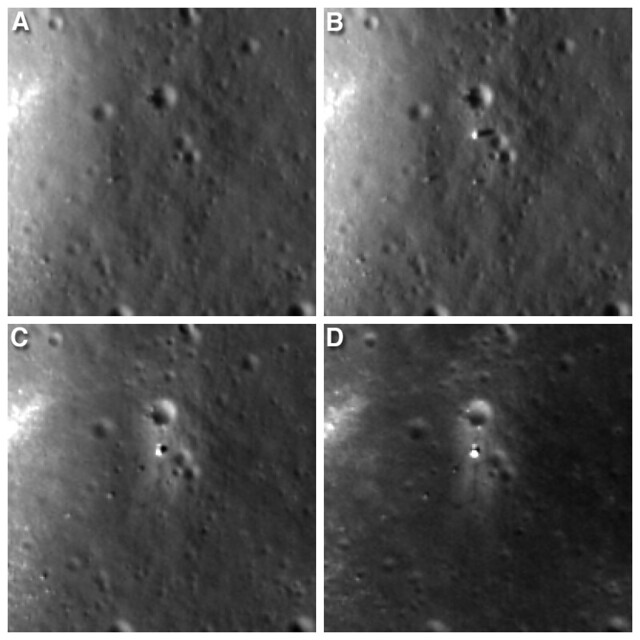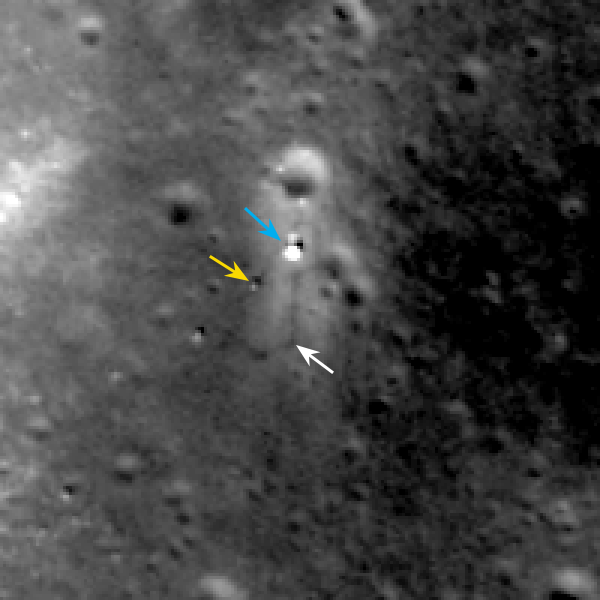Mark Robinson
Principal Investigator
Lunar Reconnaissance Orbiter Camera (LROC)
Arizona State University
Chang'e 3 landed on Mare Imbrium (Sea of Rains) on 14 December 2013. LROC has now imaged the lander and rover three times: 25 December 2013 (M1142582775R), 21 January 2014 (M1144936321L), and 17 February 2014 (M1147290066R). From month-to-month the solar incidence angle decreased steadily from 77° to 45° (incidence angle at sunset is 90°); due to the latitude of the site (44.1214°N, 340.4884°E, -2630 meters elevation) the incidence angle cannot get much smaller. Solar incidence angle is a measure of the Sun above the horizon; at noon on the equator the Sun is overhead and the incidence angle is 0°, at dawn or dusk the incidence angle is 90°.
As the Sun gets higher above the horizon, topography appears subdued and reflectance differences become more apparent. In the case of the Chang'e 3 site, with the Sun higher in the sky one can now see Yutu's tracks (February image). In the opening image you can see Yutu about 30 meters south of the lander, then it moved to the northwest and parked 17 meters southwest of the lander. In the February image it is apparent that Yutu did not move appreciably from the January location.
Owing to the lower solar incidence angle the latest NAC image better shows Yutu's tracks and the lander engine blast zone (high reflectance) that runs north-to-south relative to the lander. Next month the solar incidence angle will again increase and subtle landforms will begin to dominate the landscape.
Some Related Posts and LROC Featured Images:
Geologic Characteristics: Chang'e-3 exploration region
ESA on Yutu, as controllers wait for Feb. 9 sunrise
Chang'e 3 Lander and Rover From Above
Safe on the Surface of the Moon
Recent Impact
Coordinates of Robotic Spacecraft
Principal Investigator
Lunar Reconnaissance Orbiter Camera (LROC)
Arizona State University
Chang'e 3 landed on Mare Imbrium (Sea of Rains) on 14 December 2013. LROC has now imaged the lander and rover three times: 25 December 2013 (M1142582775R), 21 January 2014 (M1144936321L), and 17 February 2014 (M1147290066R). From month-to-month the solar incidence angle decreased steadily from 77° to 45° (incidence angle at sunset is 90°); due to the latitude of the site (44.1214°N, 340.4884°E, -2630 meters elevation) the incidence angle cannot get much smaller. Solar incidence angle is a measure of the Sun above the horizon; at noon on the equator the Sun is overhead and the incidence angle is 0°, at dawn or dusk the incidence angle is 90°.
 |
| Four views of the Chang'e 3 landing site from before the landing until Feb 2014 [NASA/GSFC/Arizona State University]. |
Some Related Posts and LROC Featured Images:
Geologic Characteristics: Chang'e-3 exploration region
ESA on Yutu, as controllers wait for Feb. 9 sunrise
Chang'e 3 Lander and Rover From Above
Safe on the Surface of the Moon
Recent Impact
Coordinates of Robotic Spacecraft





1 comment:
21st Century SiteMinder Training Synopsis:
http://www.21cssindia.com/courses/ca-siteminder-online-training-190.html
Through a combination of presentations and hands-on lab work, the students will go through a complete SiteMinder implementation project, including installation, configuration, deploying agents, protecting applications, maintaining, and troubleshooting.
Target Audience for Online CA SiteMinder Courses:
This course is designed for Deployment Consultants, Architects and Administrators, who
will be building, deploying and/or maintaining a SiteMinder infrastructure.
Basic Topics Covered in Our Best CA SiteMinder Online Training
Website Development Company, Website Designing Company, IT Support, ONLINE TRAINING, SEO Services, Call Us +919000444287
Courses at 21st Century Software Solutions
:
Post a Comment